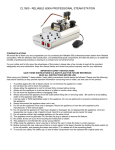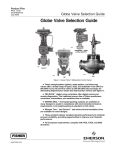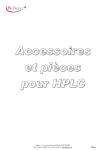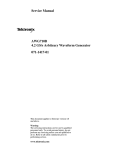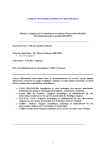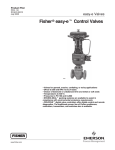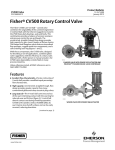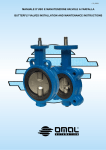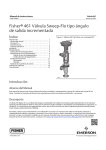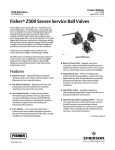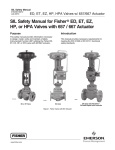Download Emerson Fisher easy-e ET Data Sheet
Transcript
Product Bulletin Cavitrol III Trims 80.2:030 March 2012 D100196X012 Fisherr Cavitrol™ III One-, Two-, and Three-Stage Trims Cavitrol III trims (figures 1, 2, and 3) are used for cavitating liquid applications in various globe and angle valve bodies (see tables 1, 2, and 3). (Contact your Emerson Process Management sales office for angle valve information.) One-stage trims are normally used where the pressure drop is below 99 bar (1440 psi); two- and three-stage trims are normally used where the pressure drop is between 99 and 207 bar (1440 and 3000 psi). The Cavitrol III trims are frequently used in pump recirculation and startup systems in the power, process, oil production, chemical refining, and other industries. W3708-1 CAVITROL III ONE-STAGE TRIM PARTS Unless otherwise noted, all NACE references are to NACE MR0175-2002. Features Controls or Helps to Eliminate Cavitation Damage–Cavitrol III trim can lengthen valve service life and reduce maintenance downtime. The shape and spacing of holes in the cage wall circumference helps prevent cavitation in a properly sized valve, effectively controlling or helping to eliminate (depending upon service conditions) cavitation damage and resulting valve failure. Rangeability–Many special characterizations are available in Cavitrol III cages to match rangeability requirements of specific systems. Resistance to Erosion Damage–Standard hardened trim materials provide excellent wear resistance, resulting in long trim life. The contoured valve plug seat reduces fluid separation, helps direct fluid away from trim, and helps protect against erosion damage. Versatility–Available in NPS 1 to 24 globe or angle valves with weld-end or flanged-end connections. www.Fisher.com W3559 CAVITROL III TWO- OR THREE-STAGE TRIM PARTS Easy Maintenance–Cage-type trim allows removal and inspection of parts without taking the valve body out of the pipeline. Fine particles very seldom cause the accumulation problem associated with labyrinth-type trim. Efficient Operation–A low inlet pressure to the final stage is maintained by the flow-down configuration and the successively larger flow area of each stage. At the third stage inlet (see figure 6), about 85% of the total pressure drop has already occurred and the vena contracta pressure remains above the liquid vapor pressure. This helps to prevent cavitation in a properly-sized valve. Trim Interchangeability–Cavitrol III one-stage trim is interchangeable with standard trims. Quick trim changes can be made with no additional parts, such as spacers, longer bolts, and special gaskets for valve sizes greater than NPS 1. Product Bulletin Cavitrol III Trims 80.2:030 March 2012 D100196X012 Specifications Construction Materials Available Valves One-stage: See table 1 Two- and three-stage Cavitrol III: See table 3 Two- and three-stage Characterized Cavitrol III: Consult your Emerson Process Management sales office See table 5 Temperature Capabilities(1) One-stage: -29 to 232_C (-20 to 450_F) Two- and three-stage: See table 5 and figure 7 End Connection Styles Refer to appropriate valve bulletin Flow Characteristic Shutoff Classification Class IV (standard for one-stage trim only): [0.01% of valve capacity at full travel tested with air at 3.4 bar (50 psid)] per ANSI/FCI 70-2 and IEC 60534-4 Class V (standard for two- and three-stage trims, optional for one-stage trim): [5x10-12m3/sec/bar/mm of port diameter (0.0005 mL/min/psid/in) of water at service pressure drop] per ANSI/FCI 70-2 and IEC 60534-4 TSO (Tight Shutoff Trim) (optional for one-, two-, and three-stage trims): Valves with TSO trim are factory tested to a more stringent Emerson test requirement of no leakage at time of shipment using ANSI/FCI Class V procedures. Consult your Emerson Process Management sales office for additional information. See figure 5 Standard Cage: Linear Characterized Cage: Consult your Emerson Process Management sales office Flow Direction Flow down (in through cage openings and out through seat ring as shown in figure 2) Flow Coefficients(2) Values given in tables 2 and 3; also see Fisher Catalog 12 Valve Recovery Coefficients(2) FL of One-Stage Cage: See table 2 FL of Two-Stage Cage: 0.98 FL of Three-Stage Cage: 0.99 These values define the maximum allowable pressure drop that is effective in producing flow as shown in the following equation: Maximum Inlet Pressures(1) Consistent with applicable ASME B16.34 pressure/temperature ratings as shown in tables 1 and 3 up to 232_C (450_F) nPallowable = FL [P1(flowing) - rc Pv] Where nPallowable =maximum allowable pressure drop that is effective in producing flow, bar (psi) P1(flowing) =flowing inlet pressure, bar, absolute (psia) rc =critical pressure ratio from Catalog 12 Pv =vapor pressure of liquid at inlet temperature, bar, absolute (psia) Maximum Pressure Drop(1) One-stage: 99.3 bar (1440 psi) but do not exceed the maximum pressure and temperature for the class rating of the valve body material used Two-stage: 149 bar (2160 psi), but do not exceed maximum allowable inlet pressure Three-stage: 207 bar (3000 psi), but do not exceed maximum allowable inlet pressure Pressure drops are valve size and trim stage dependent. For additional Cavitrol trim application guidelines, contact your Emerson Process Management sales office. Port Diameters and Circumferences See tables 1 and 3 Maximum Valve Plug Travel See tables 2 and 3 - continued - 2 Product Bulletin Cavitrol III Trims 80.2:030 March 2012 D100196X012 Specifications (continued) Minimum Seating Force Refer to figure 4 to determine minimum seat load per unit of port circumference; multiply that value by the port circumference from table 1 or Catalog 14 Valve Plug Stem and Yoke Boss Diameters See tables 1, 6, and 7 and figure 8 Valve Plug Unbalance Area See tables 1, 3, and 4 Noise Level Use Emerson Process Management liquid noise prediction methods available in the Emerson Process Management sizing program Options J Cage with Special Characterization or J Valve Plug for applications over 232_C (450_F) 1. The pressure/temperature limits in this bulletin and any applicable standard or code limitation for valve should not be exceeded. 2. For standard linear cage. Consult your Emerson Process Management sales office for flow coefficients and valve recovery coefficients of cages with optional characteristics. Principle of Operation Cavitation, the formation and subsequent collapse of vapor bubbles in liquid flow streams, is a major source of damage in control valves and adjacent piping. As liquid passes through a restriction in a control valve, the liquid velocity increases, while the liquid pressure decreases. The pressure reaches a minimum at a point called the vena contracta, and if the pressure at this point falls to or below the vapor pressure of the liquid (the pressure at which the liquid vaporizes), vapor bubbles form in the flow stream. Downstream of the vena contracta, flow area increases, velocity decreases, and pressure increases. If this recovered pressure is sufficient to raise the pressure above the liquid vapor pressure, the vapor bubbles will collapse. The collapsing bubbles generate significant noise and vibration, and can mechanically attack pipe walls and valve components. This attack can lead to the failure of conventional valve components, particularly the valve plug and seat ring. Cavitrol III One-Stage Trim The Cavitrol III one-stage trim (figures 1 and 2) can effectively eliminate cavitation damage in a properly sized and selected control valve. Each cage hole is shaped to create a small flow stream with a vena contracta pressure higher than that typically present in the flow stream of a standard cage. This higher vena contracta pressure reduces the fluid's tendency to cavitate. Each hole in a Cavitrol III one-stage cage is also designed to reduce fluid turbulence, and the holes are spaced diametrically around the cage circumference; both features dissipate fluid pressure and help to increase capacity. Cavitrol III one-stage trim can also be used to control cavitation damage. When selected and sized for this type of service, the radius edge on the valve plug and the diametrically opposed cage holes direct the cavitating fluid flow away from metal surfaces into the valve body cavity void. In this manner, damage from cavitating fluid flow is controlled. Service conditions of each application govern whether cavitation damage is effectively eliminated or controlled. Cavitrol III Two- and Three-Stage Trims The Cavitrol III two-and three-stage cages are concentric cylinders (or stages) (figure 3) with specially-shaped orifices. The choice of cage depends on the inlet pressure and the required pressure drop. In operation, liquid passes through the orifices in each stage, undergoing a portion of the total required pressure drop. This partial pressure drop in each stage of a properly-sized valve normally prevents the liquid pressure from falling to or below its vapor pressure, eliminating the formation of vapor bubbles. A characterized Cavitrol III two-or three-stage trim can be specified on those applications where the pressure drop across the valve decreases with increasing valve plug travel. Characterized Cavitrol III two- or three-stage trim consists of two or three stages at the beginning of valve plug travel. Then, as the valve is required to take less pressure drop, cage sections with fewer stages are used. 3 Product Bulletin Cavitrol III Trims 80.2:030 March 2012 D100196X012 Figure 1. Sectional View of Fisher ET Valve with Cavitrol III One-Stage Trim FLOW W3746-2 Figure 2. Operation of Cavitrol III One-Stage Trim Figure 3. Fisher HPT with Cavitrol III Three-Stage Trim 52B6045-D W6962 W3747-2 4 FLOW FLOW Product Bulletin Cavitrol III Trims 80.2:030 March 2012 D100196X012 Table 1. Additional Specifications for Cavitrol III One-Stage Trim VALVE RATING AND DESIGN CL125 through 600 ET CL600 EWT CL150 through 600 EUT-2 VALVE SIZE, NPS UNBALANCE AREA PORT CIRCUMFERENCE STEM DIAMETER(2) YOKE BOSS DIAMETER mm Inch cm2 Inch2 mm Inch mm Inch mm Inch 1 33.3 1.3125 0.13 0.02 104.6 4.12 12.7 1/2 71 2-13/16 1-1/2 47.6 1.875 0.20 0.031 149.6 5.89 12.7 1/2 71 2-13/16 1/2 3/4 71 90 2-13/16 3-9/16 2 58.7 2.3125 0.25 0.038 184.4 7.26 12.7 19.1 2-1/2 73.0 2.875 0.30 0.047 229.4 9.03 12.7 19.1 1/2 3/4 71 90 2-13/16 3-9/16 3 87.3 3.4375 0.36 0.056 274.3 10.80 12.7 19.1 1/2 3/4 71 90 2-13/16 3-9/16 4 111.1 4.375 0.50 0.077 349.0 13.74 19.1 25.4 3/4 1 90 127 3-9/16 5 6 177.8 7 0.84 0.13 558.5 21.99 25.4 or 31.8 1 or 1-1/4 127 5 8 203.2 8 0.97 0.15 638.3 25.13 25.4 or 31.8 1 or 1-1/4 127 5 4x2 58.7 2.3125 0.25 0.038 184.4 7.26 12.7 19.1 1/2 3/4 71 90 2-13/16 3-9/16 6x4 or 8x4 111.1 4.375 0.50 0.077 349.0 13.74 19.1 25.4 3/4 1 90 127 3-9/16 5 8x6 or 12x6 177.8 7 0.84 0.13 558.5 21.99 25.4 or 31.8 1 or 1-1/4 127 5 10x8 or 12x8 203.2 8 0.97 0.15 638.3 25.13 25.4 or 31.8 1 or 1-1/4 127 5 16 374.7 14.75 4.19 0.65 1177 46.32 31.8 1-1/4 127 5 374.7 14.75 4.19 0.65 1177 46.32 31.8 1-1/4 127 5 463.6 18.25 5.29 0.81 1456 57.31 31.8 1-1/4 127 5 279.4 11 3.16 0.49 877.3 34.54 31.8 1-1/4 127 5H 20x16 and CL150 24x16 through 600 EWT-2 24x20 CL150 through 600 Large ET PORT DIAMETER(1) 12, 14, and 16 1. Same as ET or EWT port diameter. Also listed in valve bulletin. 2. When two stem diameters are shown for a particular valve size, the smaller stem diameter is standard and the larger stem diameter is optional. 5 Product Bulletin Cavitrol III Trims 80.2:030 March 2012 D100196X012 Table 2. Valve Travels and Flow Coefficients (Cavitrol III One-Stage Trim) VALVE RATING AND DESIGN STANDARD VALVE SIZE, NPS CL125 through 600 ET CL600 EWT CL150 through 600 EUT-2 Cv Max Cv 1 1-1/2 2 2-1/2 19 19 29 38 0.75 0.75 1.125 1.5 1.9 2.5 3.9 4.2 12.2 19.4 36.1 64.4 25 22 ----- 1 0.875 ----- 15.5 22.5 ----- 0.90 0.93 0.93 0.91 3 4 6 8 38 51 51 76 1.5 2 2 3 4.6 5.2 10 15 81.5 148 238 408 41 54 57 86 1.625 2.125 2.25 3.375 86.7 151 259 439 0.89 0.90 0.91 0.94 4x2 6x4 8x4 29 51 51 1.125 2 2 3.9 5.2 5.2 43.6 162 165 --54 54 --2.125 2.125 --169 171 0.91 0.95 0.95 8x6 12x6 10x8 12x8 51 51 76 76 2 2 3 3 10 10 15 15 267 280 418 433 57 57 76 86 2.25 2.25 3.375 3.375 293 305 455 487 0.93 0.93 0.92 0.90 203 8 46 1790 --- --- --- 0.91 276 10.88 46 2120 --- --- --- 0.91 276 10.88 46 2390 --- --- --- 0.91 378 14.88 46 2800 --- --- --- 0.91 276 10.88 46 2390 --- --- --- 0.91 378 14.88 46 2800 --- --- --- 0.91 429 16.88 46 2940 --- --- --- 0.91 276 10.88 56 3160 --- --- --- 0.91 378 14.88 56 3810 --- --- --- 0.91 429 16.88 56 4050 --- --- --- 0.91 12 203 8 40 1160 --- --- --- 0.91 14 203 8 40 1262 --- --- --- 0.91 16 203 8 40 1330 --- --- --- 0.91 24x16 24x20 1. Valves should not be required to throttle at a Cv less than the minimum Cv for an extended period of time. Erosion damage to the valve seats may result. 2. Minimum Cv for the Optional category is the same as the minimum Cv in the Standard category. Figure 4. Required Seat Force for Class IV and V Shutoff Classification 150 200 250 300 350 400 REQUIRED SEAT LOAD (LB PER LINEAL INCH) 170 900 160 800 140 150 130 700 120 110 600 100 500 CLASS V 400 70 60 300 CLASS IV A2222-6 50 40 30 100 0 90 80 CLASS V (METAL SEAT FOR OPTIMUM PERFORMANCE AND LIFE IN BOILER FEEDWATER SERVICE. REQUIRED SEAT LOAD (N PER LINEAL mm) SHUTOFF PRESSURE DROP,BAR 0 50 100 1000 200 0 20 10 1000 2000 3000 4000 5000 6000 SHUTOFF PRESSURE DROP, PSI NOTE: CLASS IV SHUTOFF IS FOR CAVITROL III ONE-STAGE TRIM ONLY 6 FL at Maximum Travel Inch 20x16 CL150 through 600 Large ET Min(1) mm 16 CL150 through 600 EWT-2 Travel OPTIONAL FOR DESIGN ET AND EWT DUE TO OVERTRAVEL Maximum Travel Max Cv(2) mm Inch Product Bulletin Cavitrol III Trims 80.2:030 March 2012 D100196X012 Figure 5. Detail of TSO (Tight Shutoff Trim) Protected Soft Seat INNER PLUG OUTER PLUG CAVITROL HOLE CAGE PROTECTED SOFT SEAT SEAT RING A7039-1 Figure 6. Pressure Drop Patterns (Cavitrol III Three-Stage Trim) INLET PRESSURE CONVENTIONAL “EQUAL DROP” THREE-STAGE CAGE PRESSURE CAVITROL III THREE-STAGE CAGE Pv A2962 INLET PRESSURE TO THIRD STAGE P2 VENA CONTRACTA PRESSURE 1 2 3 FLUID TRAVEL THROUGH THE VALVE STAGES 7 Product Bulletin Cavitrol III Trims 80.2:030 March 2012 D100196X012 Table 3. Standard Cavitrol III Trim (Linear Characteristic for Cavitrol III Two-Stage Trims)(1, 2) Port Diameter Travel VALVE BODY RATING AND DESIGN VALVE SIZE, NPS mm Inch mm Inch Min(3) Cv Max Cv CL600 ET 1 1-1/2 2 2-1/2 3 4 6 8 25.4 33.3 47.6 58.7 73.0 73.0 136.5 177.8 1 1.3125 1.875 2.3125 2.875 2.875 5.375 7 25 38 51 64 76 102 102 152 1 1.5 2 2.5 3 4 4 6 0.28 0.44 0.92 1.1 1.2 1.9 3.0 7.0 CL600(4, 6) EWT 4x2 6x4 8x4 8x6 12 x 6 12 x 8 47.6 73.0 73.0 136.5 136.5 177.8 1.875 2.875 2.875 5.375 5.375 7 51 102 102 127 152 152 2 4 4 5 6 6 3, 4 x 3 47.6 1.875 64 4, 6 x 4 73 2.875 70 6, 8 x 6 111.1 4.375 95 1 22.2 0.875(5) 2 44.5 1 CL2500 EHT CL900 and 1500 HPAS and HPAT CL2500 HPAS and HPAT CL900, 1500, and 2500 HPS and HPT CL900 and 1500 HPS and HPT UNBALANCE AREA cm2 Inch2 FL at Maximum Travel 5.8 9.4 21 33 49 69 144 265 0.13 0.13 0.20 0.25 0.30 0.30 0.65 0.84 0.02 0.02 0.031 0.038 0.047 0.047 0.10 0.13 0.98 0.98 0.98 0.98 0.98 0.98 0.98 0.98 0.92 1.9 1.9 3.0 3.0 7.0 22 71 81.5 178 208 272 0.20 0.30 0.30 0.65 0.65 0.84 0.031 0.047 0.047 0.10 0.10 0.13 0.98 0.98 0.98 0.98 0.98 0.98 2.5 0.61 24.1 0.20 0.031 0.98 2.75 0.91 43.9 0.30 0.047 0.98 3.75 1.5 75.8 0.50 0.077 0.98 38 1.5 0.36 7.39 3.88 0.601 0.98 1.75 51 2 0.58 14.0 0.19 0.029 0.98 22.2 0.875(5) 38 1.5 0.36 6.91 3.88 0.601 0.98 2 44.5 1.75 51 2 0.58 14.0 0.19 0.029 0.98 1 22.2 0.875(5) 38 1.5 0.36 7.39 3.88 0.601 0.98 2 44.5 1.75 51 2 0.58 14.0 0.19 0.029 0.98 3 63.5 2.5 64 2.5 0.73 34.4 0.26 0.041 0.98 4 87.3 3.4375 76 3 0.90 58.1 0.31 0.056 0.98 6 133.4 5.25 102 4 1.72 123 0.59 0.092 0.98 1. Characterized cages are available. Consult your Emerson Process Management sales office for information. 2. Cv as low as 0.04 is available. Consult your Emerson Process Management sales office for information. 3. Valves should not be required to throttle at a Cv less than the minimum Cv for an extended period of time. Erosion damage to the valve seats may result. 4. Values for CL900 NPS 8 x 6 and 12 x 8 EWT available in two-stage trim same as CL600 NPS 8 x 6 and 12 x 8 EWT. 5. Cavitrol III trim in the CL1500 and 2500, NPS 1, two-stage and in the NPS 2, three-stage valve uses unbalanced valve plugs. These sizes and constructions are Design HPS/HPAS valves; other valves in this section of the table are HPT/HPAT valves. 6. For larger sizes, consult your Emerson Process Management sales office. Table 4. Standard Cavitrol III Trim (Linear Characteristic for Cavitrol III Three-Stage Trims)(1,2) VALVE BODY RATING AND DESIGN VALVE SIZE, NPS Port Diameter Inch Min(3) Cv Max Cv UNBALANCE AREA cm2 Inch2 Travel FL at Maximum Travel mm Inch mm 3, 4 x 3 33.3 1.3125 64 2.5 0.73 13.1 0.13 0.02 0.99 4, 6 x 4 58.7 2.3125 70 2.75 1.0 20.8 0.25 0.038 0.99 6, 8 x 6 111.1 4.375 95 3.75 2.8 66.7 0.50 0.077 0.99 CL900, 1500, and 2500 HPAS and HPAT 1 --- --- --- --- --- --- --- --- --- 2 25.4 1(4) 51 2 0.59 6.73 5.06 0.785 0.99 CL900, 1500, and 2500 HPS and HPT 1 --- --- --- --- --- --- --- --- --- 2 25.4 1(4) 51 2 0.59 6.73 5.06 0.785 0.99 3 47.6 1.875 38 1.5 1.20 16.5 0.20 0.031 0.99 4 73 2.875 76 3 1.70 27.8 0.30 0.047 0.99 6 115.9 4.5625 102 4 3.10 65.0 0.52 0.080 0.99 CL2500 EHT CL900 and 1500 HPS and HPT 1. Characterized cages are available. Consult your Emerson Process Management sales office for information. 2. Cv as low as 0.04 is available. Consult your Emerson Process Management sales office for information. 3. Valves should not be required to throttle at a Cv less than the minimum Cv for an extended period of time. Erosion damage to the valve seats may result. 4. Cavitrol III trim in the CL1500 and 2500, NPS 1, two-stage and in the NPS 2, three-stage valve uses unbalanced valve plugs. These sizes and constructions are HPS/HPAS valves; other valves in this section of the table are HPT/HPAT valves. 8 Product Bulletin Cavitrol III Trims 80.2:030 March 2012 D100196X012 Table 5. Trim Material and Temperature Limit VALVE DESIGN VALVE RATING TRIM DESIGNATION VALVE PLUG ET CL600 76 Heat-treated S42000 (420 SST) EWT CL600 and 900 76 Heat-treated S42000 EHT SEAT RING VALVE STEM BONNET SPACER(6, 7) S17400 (17-4PH SST) S17400 stainless with H900 heat-treat steel with H900 S31600 stainless S31600 stainless condition steel (316 SST) steel (316 SST) heat-treat condition S31600(1) S17400 stainless steel S17400 stainless with H900 heat-treat steel with H900 S31600 stainless S31600 stainless condition steel steel heat-treat condition (1) S31600 S44004 CB7CU-1 (17-4PH SST) S31600 stainless with H1075 heat-treat None S17400 steel condition H1150 chrome coat(2) CoCr-A 58 Heat-treated S44004 (440C SST) 59 S31600 with CoCr-A seat and guide CB7CU-1 with H1150 heat-treat condition 205A Heat-treated S44004 S17400 stainless steel with H1075 heat-treat condition S44004 S20910 stainless Same as body / steel bonnet material 205B Heat-treated S44004 S17400 stainless steel with H1075 heat-treat condition S44004 S31600 stainless Same as body / steel bonnet material S31600 with S17400 stainless steel 206 (NACE)(3,4) CoCr-A seat and with double H1150 guide heat-treat condition S31600/ CoCr-A S20910 stainless Same as body / steel bonnet material CL2500 HPS, HPAS, CL900 HPT, and and 1500 HPAT CAGE S17400 H1150 chrome coat(2) S31600 stainless steel MAXIMUM TEMPERATURE _C _F See figure 7 See figure 7 232(5) 450(5) None 1. Second material shown is cage retainer. 2. Second material shown is seat ring retainer. 3. If using valve body/trim combinations other than those listed, consult your Emerson Process Management sales office. 4. NACE MR0175-2002. 5. NPS 1 2 stage and NPS 2 3 stage HPS can be used at temperatures up to 343_C (650_F). 6. Bonnet spacer is not used with easy-e™ and EW series one-stage trims or with EH Series valves. 7. Bonnet spacer is used only with 2-stage trims in NPS 2 HPT/HPAT valves. 9 Product Bulletin Cavitrol III Trims 80.2:030 March 2012 D100196X012 Figure 7. Pressure Drop/Temperature Capabilities with Seal Ring (Cavitrol III Two- and Three-Stage Trims) Ordering Information When ordering, specify: Application Information 1. Process liquid–State particle size and type of entrained impurities, if any. 2. Specific gravity of liquid 3. Temperature and vapor pressure of liquid 4. Critical pressure 2 1 5. Range of flowing inlet pressures 6. Pressure drops a. Range of flowing pressure drops b. Maximum at shutoff 7. Flow rates a. Minimum controlled flow A2963-1 NOTES: 1 FOR BOTH GLASS-FILLED AND GRAPHITE-FILLED PTFE AND N10276 SEAL RING 2 FOR PEEK ANTI-EXTRUSION RING WITH GRAPHITE-FILLED PTFE AND N10276 SEAL RING 3. DO NOT EXCEED 143 BAR (2160 PSI) WITH TWO-STAGE CAVITROL III CAGE. 4. PEEK REQUIRED FOR ALL BOILER FEEDWATER APPLICATIONS. 5. FOR STAINLESS STEEL PRESSURE BOUNDARY MATERIALS, CONTACT YOUR EMERSON PROCESS MANAGEMENT SALES OFFICE. b. Normal flow c. Maximum flow 8. Required Cv 9. Line size and schedule Valve Body Information To determine what information is needed for ordering the valve body and trim, refer to the Specifications section. Review the description at the right of each specification or in the referenced tables, figures, and bulletins, and indicate the desired choice wherever a selection is to be made. Always specify the body design being ordered as selected from table 1 or 3. Installation Valve bodies with Cavitrol III trim must be installed so that the flow direction is in through the cage openings and out through the seat ring. This will be indicated by an arrow on the valve body. Exterior dimensions for ET and EWT valve bodies with Cavitrol III one-stage trim and EHT valve bodies with Cavitrol III trims do not change from their standard trim constructions. For ET and EWT valve bodies with Cavitrol III two-stage trims, see figure 8 and tables 6 and 7 for details of dimensions that change from standard. For all other dimensions, refer to the appropriate valve body bulletin. 10 Actuator and Accessory Information Select the specific actuator and accessories from the appropriate bulletins. Typically piston actuators must be used where the required valve plug travel is greater than 102 mm (4 inches). Typically diaphragm actuators may be used for 102 mm (4 inches) or less required travel. Specify any additional ordering information as required from actuator or accessory bulletins. If operating below minimum published Cvs (see tables 2, 3, and 4), added trim reliability may be obtained through use of low travel cutoff features available with FIELDVUE™ digital valve controllers. Product Bulletin Cavitrol III Trims 80.2:030 March 2012 D100196X012 Table 6. Non-Standard Dimensions (Cavitrol III Two-Stage Trims Only) Table 7. Non-Standard Dimensions (Cavitrol III Two-Stage Trims Only) EWT CL600(1) ET CL600 Valve Size, NPS Yoke Boss Diameter mm Inch Stem Diameter Dimension D mm Inch mm Inch Valve Size, NPS Yoke Boss Diameter mm Inch Stem Diameter Dimension D mm Inch mm Inch 4x2 71 90 2-13/16 3-9/16 12.7 19.1 1/2 3/4 252 249 9.94 9.81 6x4 71 90 127 2-13/16 3-9/16 5 12.7 19.1 25.4 or 31.8 1/2 3/4 1 or 1-1/4 346 343 389 13.62 13.50 15.32 9.06 8.94 8x4 260 257 10.25 10.12 71 90 127 2-13/16 3-9/16 5 12.7 19.1 25.4 or 31.8 1/2 3/4 1 or 1-1/4 348 344 391 13.69 13.56 15.38 8 x 6(2) 3/4 1 308 379 12.12 14.94 90 127 3-9/16 5 19.1 25.4 or 31.8 3/4 1 or 1-1/4 402 446 15.82 17.56 12 x 6(2) 19.1 25.4 or 31.8 3/4 1 or 1-1/4 337 406 13.25 16.00 90 127 3-9/16 5 19.1 25.4 or 31.8 3/4 1 or 1-1/4 478 522 18.82 20.56 10 x 8 19.1 25.4 or 31.8 3/4 1 or 1-1/4 511 586 20.12 23.06 90 127 3-9/16 5 19.1 25.4 or 31.8 3/4 1 or 1-1/4 511 586 20.12 23.06 12 x 8 90 127 3-9/16 5 19.1 25.4 or 31.8 3/4 1 or 1-1/4 559 613 22.00 24.12 1 71 2-13/16 12.7 1/2 184 7.25 1-1/2 54 71 2-1/8 2-13/16 9.5 12.7 3/8 1/2 155 178 6.12 7.00 2 71 90 2-13/16 3-9/16 12.7 19.1 1/2 3/4 202 198 7.94 7.81 2-1/2 71 90 2-13/16 3-9/16 12.7 19.1 1/2 3/4 230 227 3 71 90 2-13/16 3-9/16 12.7 19.1 1/2 3/4 4 90 127 3-9/16 5 19.1 25.4 6(1) 90 127 3-9/16 5 8 90 127 3-9/16 5 1. 102 mm (4 inch) travel construction. D dimension does not change for 51 mm (2 inch) travel construction. 1. CL600 and CL900 NPS 8 x 6 and 12 x 8 are the same. 2. Long travel construction. D dimension does not change for 51 mm (2 inch) travel construction. Figure 8. Non-Standard Dimensions (Cavitrol III Two-Stage Trims Only) (also see tables 6 and 7) MATCH LINE FOR 585C SERIES ACTUATORS AND 657 667 SIZE 100 ACTUATORS MATCH LINE FOR ALL OTHER ACTUATORS MATCH LINE FOR ACTUATOR 25.4 (1.00) D 14A4969-E A2966-3 71 OR 90 mm (2-13/16 OR 3-9/16 INCH) DIAMETER YOKE BOSS 127 mm (5-INCH) DIAMETER YOKE BOSS D mm (INCH) 11 Product Bulletin 80.2:030 March 2012 Cavitrol III Trims D100196X012 Neither Emerson, Emerson Process Management, nor any of their affiliated entities assumes responsibility for the selection, use or maintenance of any product. Responsibility for proper selection, use, and maintenance of any product remains solely with the purchaser and end user. Fisher, Cavitrol, easy-e, and FIELDVUE are marks owned by one of the companies in the Emerson Process Management business unit of Emerson Electric Co. Emerson Process Management, Emerson, and the Emerson logo are trademarks and service marks of Emerson Electric Co. All other marks are the property of their respective owners. The contents of this publication are presented for informational purposes only, and while every effort has been made to ensure their accuracy, they are not to be construed as warranties or guarantees, express or implied, regarding the products or services described herein or their use or applicability. All sales are governed by our terms and conditions, which are available upon request. We reserve the right to modify or improve the designs or specifications of such products at any time without notice. Emerson Process Management Marshalltown, Iowa 50158 USA Sorocaba, 18087 Brazil Chatham, Kent ME4 4QZ UK Dubai, United Arab Emirates Singapore 128461 Singapore www.Fisher.com E 121996, 2012 Fisher Controls International LLC. All rights reserved.












